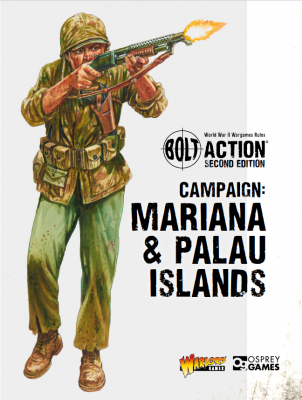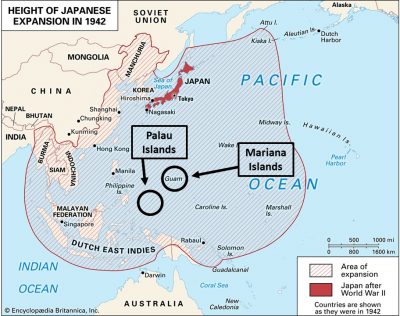Recon Report – Bolt Action: Campaign: Mariana and Palau Islands
 By Kreighton Long
By Kreighton Long
Last week Warlord Games made the new book available for pre-order. This latest addition to their inventory of Bolt Action supplemental materials provides just over 150 pages of new content for fans of the 28mm World War Two skirmish game.
Focused on two campaigns in the South Pacific, this book attempts to provide engaging scenarios and unique unit and theater options for players representing the Japanese and United States combatants of the war.
The battles for the Marianas and Palau Islands all occurred during the summer and autumn of 1944, half a world away from the violent crescendos of the Normandy landings and Operation Market Garden in western Europe and Operation Bagration in eastern Europe.
The United States entered Wor ld War II by declaring war on Japan on 8 December 1941, the day following the attack on Pearl Harbor – “…a date which will live in infamy” as immortalized by US President Franklin Roosevelt.
ld War II by declaring war on Japan on 8 December 1941, the day following the attack on Pearl Harbor – “…a date which will live in infamy” as immortalized by US President Franklin Roosevelt.
At the same time the military installations on Oahu, Hawaii were under attack from the air, the Japanese military struck targets across the Pacific.
A quick string of victories followed for the Japanese military but defeat at the hands of the US Navy at The Battle of Midway in June 1942 shifted momentum and presented US military commanders with an opportunity to take the initiative. That hammer blow fell on the island of Guadalcanal, in the Solomon Islands, in August 1942.
The Guadalcanal campaign lasted from August 1942 until February 1943 and began the island-hopping campaign. The island-hopping strategy saw the US Army, Navy, Marines, and Army Air Force (soon to be reborn in 1947 as the United States Air Force) jointly skip over strong Japanese held islands. Instead, the US isolated them by air and sea and struck supposedly weaker defended islands.
 The idea of investing strength against reportedly weaker held islands did not always go according to plan as some battles raged far longer and far fiercer than US commanders planned for. For example, US commanders claimed the battles of Peleliu and Angular, engagements covered in this book, would last three days instead of the horrifying 74 days it dragged on for.
The idea of investing strength against reportedly weaker held islands did not always go according to plan as some battles raged far longer and far fiercer than US commanders planned for. For example, US commanders claimed the battles of Peleliu and Angular, engagements covered in this book, would last three days instead of the horrifying 74 days it dragged on for.
Despite the occasional setback, the island hopping plan succeeded and by 1945 the US military was planning for an invasion of the Japanese mainland when the Japanese surrendered, after not-so-gentle nudging by two atomic bombs dropped in August 1945.
Immediately following the introduction, author Mark Gallear outlines the four types of scenarios found in the book. Due to the similar flow of events that most ground fighting found themselves in all scenarios can fit into one of the following scenario types: Beach Landing (get on the beach!), Counter-attack (stay on the beach!), Advance (get off the beach!), and Strongpoint Assault (they’re dug in like a tick, sir!).
Establishing a template for the different scenarios to fit under makes setting up and scoring the different scenarios more standardized, giving players more time to roll dice instead of reading the scenario and rule books. Under the Marianas Campaign section, readers will find the history, scenarios, and theater selectors for the battles of Saipan, Guam, and Tinian. The battles of Peleliu and Anguar make up the Palau Islands Campaign. Fans of HBO’s The Pacific may recognize the Battle of Peleliu from the middle arc of the series as the story follows Eugene Sledge onto the beaches, across the airfield, and into Bloody Nose Ridge. All three of those engagements are present in the book for gamers looking to recreate these battles.
To add flavor to the twenty-one scenarios, this book includes special rules intended for games covering the Pacific Theater of Operations. These special rules can supplement these scenarios or can be applied to player-made scenarios featuring fighting over other islands in the Pacific.

Such rules include Amphibious Assaults with rules for moving in water, landing craft to get troops on the beach, and different types of underwater terrain feature landing craft would have to overcome to make it to the beach such as sand flats, lagoons, reefs, and coral atolls.
Most of the fighting in the Pacific featured one side throwing themselves the prepared positions of the enemy. Players hoping to reenact wars of maneuver should look to the European Theater of Operations, with some exceptions. Accordingly, this book provides pages of various rules for Dug In units and different types of Fortification, including game stats and point costs.
By combining meticulous historical research, colorful unit types and army builds, and gorgeous photographs of painted miniatures in action, this book is an exciting addition to fans of the Bolt Action campaign books. Despite being a habitual European Theater painter and gamer, I couldn’t help but feel tempted to build and paint an army for the Pacific Theater after working through Campaign: Mariana and Palau Islands.
Campaign: Mariana and Palau Islands is available for pre-order .
